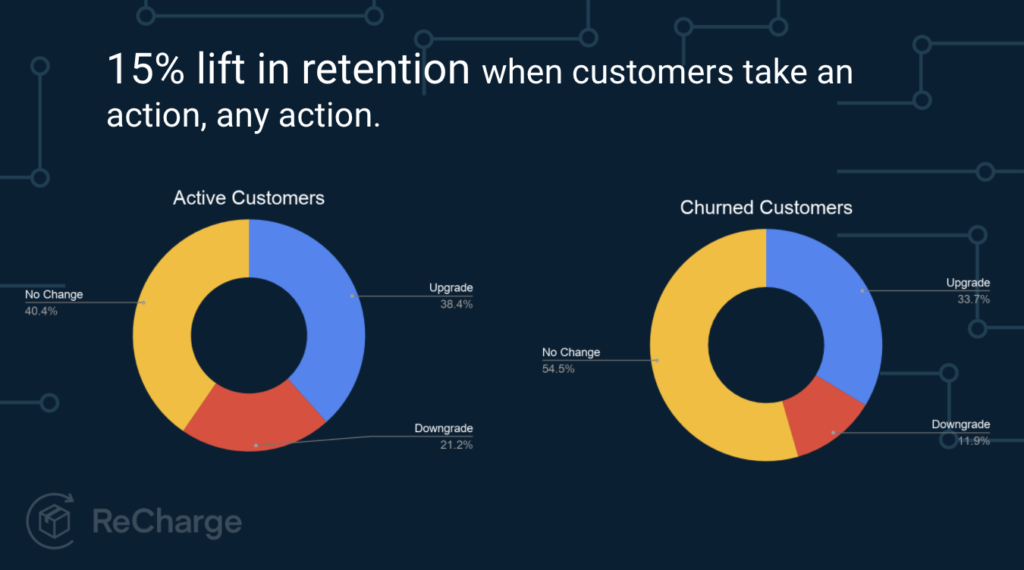What is lifetime value (LTV)? It’s the average amount a subscriber spends over the course of their subscription (average revenue per user) before churning (leaving your subscription program).
Why is it useful? It can give you clues on the health of your subscription program. For example, are customers subscribing only to take advantage of a subscribe and save discount then churning? Or does LTV indicate you’re attracting loyal customers who last for several subscription cycles?
Lifetime value can be calculated a number of different ways (from straightforward to complex) so here’s how we calculate LTV here at Recharge.
Calculating LTV
We calculate lifetime value based on the occurrences in the past for customers who have already exited the platform. The equation breaks down to annual revenue per user / churn.
This methodology matches Shopify’s reporting for the total customer value metric, an intentional synchronization on our side so that merchants have continuity reporting across the two platforms (in the future, we plan to refine this approach to include other calculations as we continually strive to always improve our analytics platform).
LTV subscription trends
Since the pandemic was declared in March 2020 our merchants saw explosive growth in subscribers while LTV grew at a lower pace. Our data shows 90% growth in subscribers across all verticals and an average LTV growth of 11% from January 1, 2020 to December 31, 2020.
Our conclusion — more and more people are trying out subscriptions for the first time. Customers are checking out new brands and spending more on average than they did in years past. This rush on subscriptions shows no signs of slowing down with the global subscription ecommerce market forecast to reach $478.2 billion by 2025.
Our results also amplify the importance of brands making a good first impression to boost retention (and in turn grow LTV). It’s great to have a wave of new customers flocking to businesses. But if they’re churning out right away, you’ve got a problem and need to look at your retention strategies.
Our advice? Subscription brands that will have the most success in the new roaring twenties will be embracing relational commerce.
For a deeper look at the seismic impact 2020 had on the subscription economy, check out our State of Subscription Commerce Report (and here’s a look at last year’s).
Dig deeper
What’s important to remember about LTV is the highest value metric it excludes customers who haven’t churned. These customers, your most loyal subscribers, aren’t included in the lifetime value metric as they have yet to leave your subscription program. That makes them your most valuable customers.
Some businesses try to navigate this data gap by predicting when future customers may churn. Others add further complexity by analyzing multiple LTVs among various customer cohorts based on when they’ve made changes to their subscription program.
However your business decides to calculate your lifetime value, the most important thing is consistency. On our Hit Subscribe podcast, Diane Albouy, CTO, smol, shared with us a wealth of knowledge on making data-driven decisions. Diane spoke about three important points to consider in regards to LTV:
- Create a definition consistent with your business, product and subscribers
- Stay consistent – if you sway from your original definition you’ll hurt your data accuracy
- What matters most isn’t the specific number itself, it’s how the metric changes over time

Zeroing in on that last point. Don’t get caught up in comparing your LTV to your competitors, or obsess over the number itself. Your focus should be on how that number changes over time, that delta (the change in movement) and how positively you can effect it.
Keys to success
So, in knowing it’s more about positive movement to the LTV delta, how can you set yourself up for success? First and foremost, our Powerful & Profitable Subscriptions Playbooks are an invaluable resource. Specifically our playbook on The Most Important Metrics, will give you a firsthand look at how to leverage LTV (as well as giving you a crash course in CAC, AOV, and churn prevention techniques).

Here’s a peek at some of the valuable information contained inside that particular playbook — three methods to growing lifetime value courtesy Tate Lucas, CEO at DotDash.io:
- Regularly get them GREAT content via your website, email blasts, social media, etc. This content can be seen as ancillary or complementary to your products. This will quickly showcase the added value that your brand can offer to subscribers.
- Be a good listener and show that you care. This can be done by having omnichannel support, allowing customers to find their resolutions easily and quickly. Exceptional customer service will also go a long way in building loyalty and confidence in your authority.
- Utilize upsells and cross-selling. These methods are tried and true ways to increase the individual average order value and LTV. You can do this by a variety of methods such as bundling complementing products, incentivizing higher cart/order values by offering free shipping or a gift, or bundling products together in a new SKU.
Another great way to increase LTV is by giving more flexibility to your customers current subscription. Specifically, let’s talk about Skip and Swap and how giving customers these options in their customer portal will have a positive impact on your LTV delta granting subscribers.
Skip is straightforward. Customers that have too much product are naturally inclined to cancel their subscription. But by giving subscribers a prominent skip button in their customer portal you can avoid churn altogether.
Instead subscribers delay their orders and remain a part of your subscription program. Our data shows that active subscribers, even if their activity involves skipping a subscription, are stickier and generate a higher lifetime value. Swap is another option, where a customer can easily try out a new product for a subscription period before fully committing to a brand new subscription.

On the whole our data shows that engaged customers (those who take actions like skip or swap in their customer portal) stay around twice as long as unengaged customers. So empowering customers to manage their own subscriptions with actions like Skip Swap or One-Time Products will result in major boons for your business.
For the final thought on LTV here’s another quote from Aaron Quinn, Founder and CEO of eHouse Studio, in our The Most Important Metrics playbook:
Leverage your subscription program to help you grow LTV. Targeting existing high-value subscribers with VIP offers, personalized recommendations, and upselling relevant products can help grow the relationship while increasing monthly subscription revenue and keeping customers in the program even longer.
Aaron Quinn, Founder & CEO, eHouse Studio



